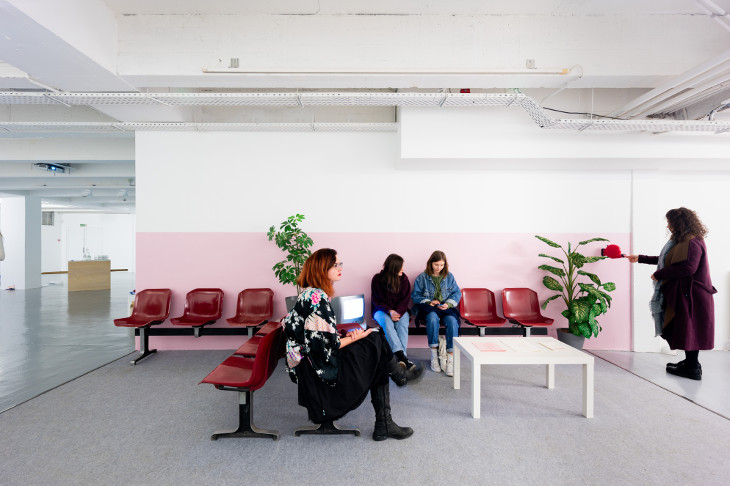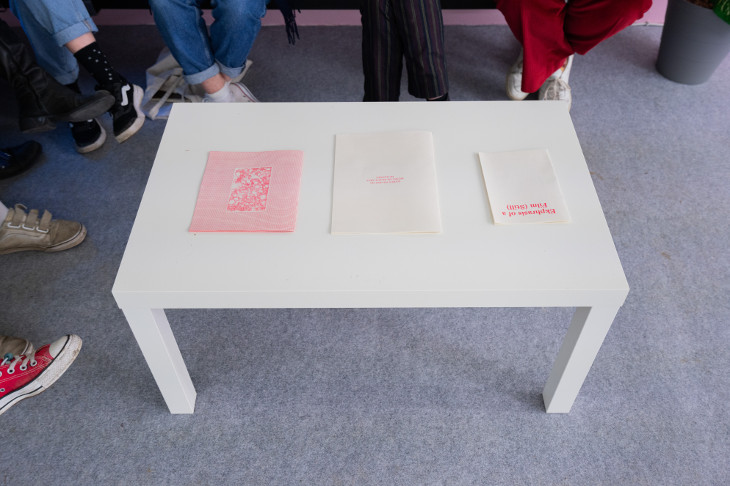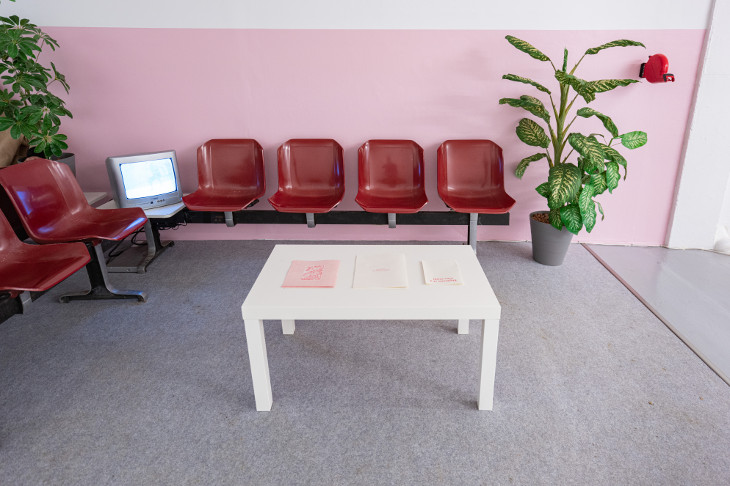The Intolerable Straight Line
Pedro Zylbertsztajn, Waiting Room, 2019
Installation
The following is an interview with the artist conducted by Victoria Quesnel, Eugénie Michaud and Manon Sehan.
Can you talk about the artwork you created for this exhibition and what you intended to do? How do you think it relates to the idea of this particular collective exhibition?
It is always hard to talk about a work while you are still somewhat consumed by it – there is a fine balance between talking about the work in a way that promotes interesting aspects of it and in a way that over prescribes it with "the artist's will," and I find that often while I'm still in the process of working on something, or still in the process of letting go of the work, I am too eager, and overshare. Simultaneously, there will always be some near-sightedness on my part, at this stage, as the work hasn't still been "out there", meeting the universe halfway, which means I can only talk about my half of this lightly treaded journey. I say this because I think it is especially pertinent to the context of this exhibition, which proposes a discussion on the often unexpected trajectories of works of art. At the point of writing, this work hasn't even started its trajectory yet – it is, conveniently, waiting for departure. In any case, I can say that I tried to make a space that evoked a heightened sense of expectation (which for me, personally, is closely related to anxiety), and played with this notion of movement and trajectory through its opposite, stillness. It speaks to other works I have made before in the sense that there are pieces of it that are notably missing, and therefore incites whoever engages with it to take a position in its completion. It differs, though, in the sense that in this case it requires less of an action in terms of meaning-making, and more in terms of a specific performatic gesture. It aims to suspend time, at least in some capacity, and depends on the viewer's (un)willingness to comply to this game of abeyance. All works in the exhibition talk to this notion of the re-apprehension of the artwork through its movement in time, and there are other related threads that I see running through the show – modes of reading and modes of quoting. My work follows suit: there are several instances of quotes within the work, from its general form, to the booklets, to the sound, to the related performance, pointing to references in and outside the exhibition, which may be more or less explicit and are always appeals to the viewer's engagement. All the while, one of the main frameworks I have for this installation is of it being a space which creates a very specific psychological condition for reading, both these references and whatever else may contamine it.
You have already participated in many collective exhibitions, right? You only had two solo exhibitions compare to eighteen collective ones. How do you explain that? Do you think collective exhibitions bring a new dimension to your work?
I feel it's important to say before anything else that this is mostly a matter of opportunity: as a young artist, most invitations I receive are for group shows. I think there is a lot to be said about how this is also a factor of the current art economy, where on one hand galleries and institutions tend to invest in group shows as a safer choice through which the can hedge their bets, and on the other hand, independent and artist run spaces aim to provide a platform for a larger community of artists and for multiple practices with limited resources. I think the ascension of the figure of the curator in the art world also plays a big part in this, as in many instances shows are more driven by specific curatorial frameworks that are better articulated through a selection of artists then they are specific curatorial perspectives on an artist's practice, and as the position of the curator as critical cultural agent has become more consolidated, these kinds of exhibitions have gained more ground too. The Kolbowski/Asher pieces from which this exhibition stems are really great points of departure to think about this, as both were commenting very pointedly at this particular mode of exhibition in two different crucial times for its establishment and development. All that being said, I do like to participate in a good collective exhibition very much. I think all of the dynamics of juxtaposition, proximity, leakage and contamination it provides can be very fruitful for the works displayed and I feel like I can sometimes read my work in an entirely different way after its placement within a larger body of carefully selected works which aren't my own. I've spent most of my career so far working in constant, sometimes daily dialogue with other people. First in art school, then sharing a studio with what eventually became a publishing collective with which I exhibited from 2014 to 2016, then during my Masters, sharing spaces, opinions and ideas. So it just makes sense when the work often ends up being in a larger conversation during its exhibition. While I'm not passing any opportunities to show solo, because I think there are other very positive reasons for doing so (not least of which the fact that the work exposes its internal dialogues more visibly), I have been in quite a few situations, such as this one, in which I was very actively engaged with the curators and the group of exhibiting artists, and we were able to formulate together a very rich discursive tapestry which I wouldn't be able to come up with by myself. These are very nourishing experiences for any practice, I think.
During a discussion about your performance entitled Brickwork, Alexandra Goldman talks about a sensation of frustration. She said: « Witnessing this was a perplexing and frustrating experience ». What do you think of this sensation that visitors sometimes feel when experiencing some of your performances? Do you anticipate that this sensation might happen and is it something that you like to provoke?
I am somewhat hesitant of talking about the idea of frustration, particularly, in relation to my work. Maybe because it is a word that is loaded with other meanings I am not comfortable with, such as impotence or resentment (which are feelings that, as we can now see around the world, can occasion very politically violent responses). However, I think it can be an interesting key in which to read my practice. I often think about it in terms of illegibility, occlusion, opacity, strangeness, and these are certainly conditions which define frustrating experiences. But what I try to attain in my work is to use this initial sense of frustration as a drive for the spectator to reconsider their position in and towards the work. In some sense I'm interested in frustrating the spectator's expectation of a mode of viewership in which the work is handed to them fully mediated – the very idea of them being spectators – and am tacitly suggesting that the way in which contact with these objects can produce (hopefully partial and temporary) fulfilment is if they are willing to negotiate with them, as readers. I think it can be a fine line to walk on, exactly because I don't want frustration to become the dominant tone of engagement with the work and end up producing a sense of impotence. So there is a constant effort to produce ways of channeling the discomfort that I have willingly generated into a sort of low-key emancipatory gesture on the part of the spectator-turned-reader. So yes, frustration is sometimes a deliberate aspect of my work, but hopefully as an initial stage to be somewhat overcome. I think the example you brought is quite relevant to this, indeed – in her review of brickwork, the writer describes her contact with the work almost as a straight line between being baffled and frustrated to being on board with the notion that it "demands another type of interaction," in her words. This work encapsulates an underlying attitude in much of my practice in regards to your question: an attempt at transfiguring being frustrated by the illegible to being intrigued by it.
On another level, do you consider that your work presents a certain humorous aspect? Also, do you think of your work as political in some way?
The presence and importance of humor in my work is something that happened very incidentally and that has only come to my attention very recently, despite being there all along. Because of this, I might not have a very eloquent answer to this question. I think it is crucial to my work, and generally what I feel are my most effective projects are the ones in which the comic components are holding the scale of all the other aspects of the work in the right balance. A lot of humor is about controlling tension, knowing when to heighten it and when to release it. I think my work can sometimes be very tense, either because of this sense of difficulty we discussed in the last question or because of a certain sense of absurdity which occasionally pops up. So being funny becomes not only kind of easy, because I have all this tension to work with, but almost a necessity to offset this previously mentioned frustration and channel it out of the road to resentment and into more pertinent sensations and modes of engagement. Also, good jokes should never be explained too much to always leave you scratching your head for a bit, and more and more I think this is an interesting model for artworks. All that being said, too often I make decisions (and entire works) based solely on the fact that I think they are funny, silly or preposterous, and this is really how humor infiltrates my practice – all this rationale is posterior and recent. When it comes to the political dimensions of my practice, then it's a very different conversation, in the sense that the politics of the work are generally in the forefront of my mind. While most of my artwork doesn't explicitly address specific political situations and themes, there is an underlying argument of language use as an instrument for constructing social reality, which means it is always engaging language's role and potential both in authority and emancipation. I make constant efforts throughout my practice to subtly undermine structures that are usually taken as a given, natural and immutable, by placing them in a strange light, as a strategy for creating new political imaginaries for language and technology. It is interesting that the matters of humor and politics are intertwined in the question, as I think I'm able to carry a lot more political weight in a project when it runs as an undercurrent, driven by metaphor, displacement, slippages and humor, rather than through full-frontal demonstration, which many times ends up submitting all the potential of the work to a single confrontation, like a spear-head. I think a lot about Italo Calvino's Six Memos, the fist of which is Lightness. In his praise for lightness, which is by no means an avoidance of the weight of the world but a suggestion for how to work with it, he mentions the mirrored shield of Perseus, which allowed him to look in the eyes of Medusa without following the fate of others and being petrified. This, Calvino says, is an apt metaphor for metaphor itself and literature as a whole: it is what allows us to look at the world, our Medusa, reflected back at us, but without the power to stop us facing it head first. I think this is an important comment on art in general, and I try to keep it close to my work.
An interview conducted by Victoria Quesnel, Eugénie Michaud and Manon Sehan (seminar “Listening to the Archives”, Master of Fine arts, Université Rennes 2).


